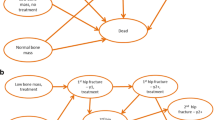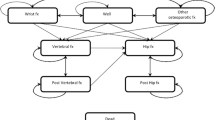Abstract
Summary
In a randomized trial, a multifaceted intervention tripled rates of osteoporosis treatment in older patients with wrist fracture. An economic analysis of the trial now demonstrates that the intervention tested “dominates” usual care: over a lifetime horizon, it reduces fracture, increases quality-adjusted life years, and saves the healthcare system money.
Introduction
In a randomized trial (N = 272), we reported a multifaceted quality improvement intervention directed at older patients and their physicians could triple rates of osteoporosis treatment within 6 months of a wrist fracture when compared with usual care (22% vs 7%). Alongside the trial, we conducted an economic evaluation.
Methods
Using 1-year outcome data from our trial and micro-costing time-motion studies, we constructed a Markov decision-analytic model to determine cost-effectiveness of the intervention compared with usual care over the patients’ remaining lifetime. We took the perspective of third-party healthcare payers. In the base case, costs and benefits were discounted at 3% and expressed in 2006 Canadian dollars. One-way deterministic and probabilistic sensitivity analyses were conducted.
Results
Median age of patients was 60 years, 77% were women, and 72% had low bone mineral density (BMD). The intervention cost $12 per patient. Compared with usual care, the intervention strategy was dominant: for every 100 patients receiving the intervention, three fractures (one hip fracture) would be prevented, 1.1 quality-adjusted life year gained, and $26,800 saved by the healthcare system over their remaining lifetime. The intervention dominated usual care across numerous one-way sensitivity analyses: with respect to cost, the most influential parameter was drug price; in terms of effectiveness, the most influential parameter was rate of BMD testing. The intervention was cost saving in 80% of probabilistic model simulations.
Conclusions
For outpatients with wrist fractures, our multifaceted osteoporosis intervention was cost-effective. Healthcare systems implementing similar interventions should expect to save money, reduce fractures, and gain quality-adjusted life expectancy.



Similar content being viewed by others
References
Burge R, Dawson-Hughes B, Solomon DH, Wong JB, King A, Tosteson A (2007) Incidence and economic burden of osteoporosis related fractures in the United States, 2005–2025. J Bone Miner Res 22:465–475
National Osteoporosis Foundation (2008) Clinicians’ guide to prevention and treatment of osteoporosis. Available at: http://www.nof.org/professionals/NOF_Clinicians_Guide.pdf/. Accessed 14 August 2010)
Scientific Advisory Council, Osteoporosis Society of Canada (2002) Clinical practice guidelines for the diagnosis and management of osteoporosis in Canada. CMAJ 167(suppl):S1–S34
Majumdar SR, Johnson JA, McAlister FA, Bellerose D, Russell AS, Hanley DA et al (2008) Multifaceted intervention to improve diagnosis and treatment of osteoporosis in patients with recent wrist fracture: a randomized controlled trial. CMAJ 178(5):569–575
Majumdar SR, Johnson JA, Lier DA et al (2007) Persistence reproducibility, and cost-effectiveness of an intervention to improve the quality of osteoporosis care after a fracture of the wrist: results of a controlled trial. Osteoporos Int 18:261–270
Majumdar SR, Lier DA, Beaupre LA, Hanley DA, Maksymowych WP, Juby AG et al (2009) Osteoporosis case-manager for hip fracture patients: results of a cost-effectiveness analysis conducted alongside a randomized trial. Arch Intern Med 169(1):25–31
Majumdar SR, Rowe BH, Folk D, Johnson JA, Holroyd BR, Morrish DW et al (2004) A controlled trial to increase detection and treatment of osteoporosis in older patients with a wrist fracture. Ann Intern Med 141:366–373
Bessette L, Ste-Marie LG, Jean S, Davison KS, Beaulieu M et al (2008) The care gap in diagnosis and treatment of women with a fragility fracture. Osteoporos Int 19:79–86
Sonnenberg F, Beck R (1993) Markov models in Medical Decision-making: a practical guide. Med Decis Mak 13(4):322–338
Tosteson AN, Jonsson B, Grima DT, O’Brien BJ, Black DM, Adachi JD (2001) Challenges for model-based economic evaluations of postmenopausal osteoporosis interventions. Osteoporos Int 12:849–857
Johnell O, Jšnsson B, Jšnsson L, Black D (2003) Cost effectiveness of alendronate for the treatment of osteoporosis and prevention of fractures. PharmacoEconomics 21:305–314
Zethraeus N, Borgstršm F, Stršm O, Kanis J, Jšnsson B (2007) Cost-effectiveness of the treatment and prevention of osteoporosis-a review of the literature and a reference model. Osteoporos Int 18:9–23
Strom O, Zethraeus N, Borgstršm F, Johnell O, Jšnsson B, Kanis J. IOF cost-effectiveness reference model: background document. International Osteoporosis Foundation. Available at: http://www.iofbonehealth.org. Accessed 5 March 2010
Klotzbuecher CM, Ross PD, Landsman PB, Abbott TA III, Berger M (2000) Patients with prior fractures have an increased risk of future fractures: a summary of the literature and statistical synthesis. J Bone Miner Res 15:721–739
Wiktorowicz ME, Goeree R, Papaioannou A, Adachi JD, Papadimitropoulos E (2001) Economic implications of hip fracture: health service use, institutional care and cost in Canada. Osteoporos Int 12:271–278
Cranney A, Guyatt GH, Griffith L, Wells G, Tugwell P, for the Osteoporosis Research Advisory Group (2002) IX: summary of meta-analyses of therapies for postmenopausal osteoporosis. Endocrinol Rev 23:570–578
Tonino RP, Meunier PJ, Emkey RD, Rodriguez-Portales JA, Menkes CJ, Wasnich RD et al (2000) Skeletal benefits of alendronate: 7-year treatment of postmenopausal osteoporotic women. J Clin Endocrinol Metab 85:3109–3115
Bone HG, Hosking D, Devogelaer JP, Tucci JR, Emkey RD et al (2004) Ten years’ experience with alendronate for osteoporosis in postmenopausal women. N Engl J Med 350:1189–1199
Solomon DH, Avorn J, Katz JN, Finkelstein JS, Arnold M, Polinski JM et al (2005) Compliance with osteoporosis medications. Arch Intern Med 165:2414–2419
Schousboe JT, Nyman JA, Kane RL, Ensrud KE (2005) Cost-effectiveness of alendronate therapy for osteopenic postmenopausal women. Ann Intern Med 142:734–741
Majumdar SR, Johnson JA, Bellerose D, McAlister FA, Russell AS, Hanley DA, et al (2010) Nurse case-manager vs multifaceted intervention to improve quality of osteoporosis care after wrist fracture: randomized controlled pilot study. Osteoporos Int doi:10.1007/s00198-010-1212-7
Alberta Health Care Insurance Plan (2006) Schedule of medical benefits (procedures and price list). Alberta Health Care, Edmonton, Alberta, Canada
Alberta Health and Wellness (2007) Drug benefits list. Alberta Health and Wellness, Edmonton, Alberta, Canada
Alberta Health and Wellness (2006) Health Costing in Alberta - Annual Report. Edmonton, Alberta, Canada
Canadian Institute for Health Information (2006) Resource intensity weights and expected length of stay. Canadian Institute for Health Information, Ottawa, Ontario, Canada
Cooper C, Atkinson EJ, O’Fallon WM, Melton LJ (1992) Incidence of clinically diagnosed vertebral fractures: a population based study in Rochester, Minnesota, 1985–1989. J Bone Miner Res 7:221–227
Statistics Canada (2006) Life tables—Canada, provinces and territories, 2000–2002 (84–537-XIE). Statistics Canada, Ottawa, Ontario, Canada
Peasgood T, Herrmann K, Kanis JA, Brazier JE (2009) An updated systematic review of health state utility values for osteoporosis related conditions. Osteoporos Int 20:853–868
Koopmanschap MA, Rutten FFH (1996) A practical guide for calculating indirect costs of disease. PharmacoEconomics 10(5):460–466
Statistics Canada (2009) Labour force survey estimates (LFS)—wages of employees by type of work, National Occupational Classification for Statistics (NOC-S), sex and age group, unadjusted for seasonality, computed annual average (Table 282-0069). Statistics Canada, Ottawa, Ontario, Canada
Dong H, Buxton M (2006) Early assessment of the likely cost-effectiveness of a new technology: a Markov model with probabilistic sensitivity analysis of computer-assisted knee replacement. Int J Technol Assess Health Care 22:191–202
Donaldson C, Currie G, Mitton C (2002) Cost-effectiveness analysis in healthcare: contraindications. BMJ 325:891–894
Lyles KW, Colon-Emeric CS, Magaziner JS, Adachi JD, Pieper CF et al (2007) Zoledronic acid and clinical fractures and mortality after hip fracture. N Engl J Med 357:1799–1809
MacLean C, Newberry S, Maglione M, McMahon M, Ranganath V et al (2008) Systematic review: comparative effectiveness of treatments to prevent fracture in men and women with low bone density or osteoporosis. Ann Intern Med 148:197–213
Majumdar SR (2008) Recent trends in osteoporosis treatment after hip fracture: improving but wholly inadequate. J Rheum 35:190–193
Acknowledgments
Sumit R. Majumdar, Jeffrey A. Johnson, Finlay A. McAlister, and Walter P. Maksymowych receive salary support awards from the Alberta Heritage Foundation for Medical Research (AHFMR); Jeffrey A. Johnson (JAJ) and Brian H. Rowe (BHR) hold Canada Research Chairs. The study was supported by peer-reviewed grants from AHFMR and the Canadian Institutes of Health Research (MOP #79325).
Conflicts of interest
None of the authors has any actual or potential conflicts of interest to declare except DA Hanley: He has been an investigator in sponsored clinical trials of alendronate and risedronate. He has received honoraria, for speaking and membership on advisory boards, from Merck Frosst Canada and Procter and Gamble.
Author information
Authors and Affiliations
Corresponding author
Additional information
Trial Registry
clinicaltrials.gov identifier: NCT00152321
Rights and permissions
About this article
Cite this article
Majumdar, S.R., Lier, D.A., Rowe, B.H. et al. Cost-effectiveness of a multifaceted intervention to improve quality of osteoporosis care after wrist fracture. Osteoporos Int 22, 1799–1808 (2011). https://doi.org/10.1007/s00198-010-1412-1
Received:
Accepted:
Published:
Issue Date:
DOI: https://doi.org/10.1007/s00198-010-1412-1




